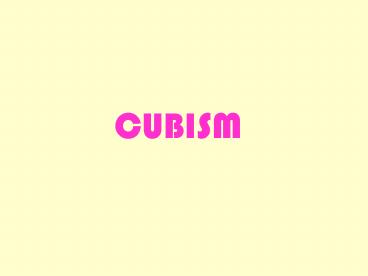CUBISM PowerPoint PPT Presentation
1 / 52
Title: CUBISM
1
CUBISM
2
Picasso, LES DEMOISELLES DAVIGNON (1907)
3
- Pablo Picasso and Georges Braque
- 1907-1914
- Emphasizes flat, two-dimensional surface
- Rejects perspective, chiaroscuro
4
Picasso, LES DEMOISELLES DAVIGNON (1907)
5
- Geometric forms without realistic detail
- Refutes art as the imitation of nature
- Conceived rather than perceived reality
- Capture essence of object by showing it from
multiple points of view simultaneously
6
Les Demoiselles dAvignon
- Subject 5 Prostitutes, seen in both frontal and
profile views
- Influence of African masks (result of recent
colonization of Africa by Europeans)
7
Picasso, LES DEMOISELLES DAVIGNON (1907)
8
Picasso, Three Women
9
Mostly monochromatic...
backlash to the impressionist periods emphasis
on light and color.
10
Picasso, Female Torso (1908)
11
The next painting is a protrait of Picassos art
dealer, Daniel-Henry Kahnweiler.
Can you find him?!
12
Picasso, Portrait of Daniel-Henry
Kahnweiler (1910)
13
Picasso, Guitar Player (1910)
14
Picasso, Girl With a
Mandolin (1910)
15
Picasso, A Woman Sitting on a
Chair (1910)
16
In some of his cubist paintings, Picasso
introduced other elements, such as collage.
17
Picasso, Bottle of VieuxMarc, Glass, Guitar
Newspaper (1913)
18
Following are some paintings by Picassos friend,
and cubisms co-founder, Georges Braque.
19
Braque, Large Nude (1908)
20
Braque, Fruit Dish (1908-1909)
21
Braque, Glass on a Table (1909-1910)
22
As did Picasso, Braque began experimenting with
more than just oil paint on canvas...
Here he uses pasted papers, chalk, charcoal on
cardboard
23
Braque, Glass, Carafe and Newspapers
(1914)
24
Sometimes, Braque used more color than Picasso,
showing the influence of the Fauves (Wild
Beasts).
25
Braque, Le Viaduct de LEstaque (1907)
26
The Fauves--their name, like so many other art
movements, originally a put-down by art
critics--were Post-Impressionists who
experimented adventurously with COLOR.
Here are a few examples
27
Henri Matisse, The Joy of Life (1905-1906)
28
Matisse, Seated Riffian (1912-1913)
29
Raoul Dufy, The Beach of Sainte-Adresse
(1906)
30
Andre Derain, St. Pauls Cathedral as seen
from the Thames (1906)
31
Derain, Charing Cross Bridge (1906)
32
Braque also exhibits the influence of
Post-Impressionist Paul Cezanne on the Cubist
movement
33
Cezanne, Turning Road at Montgeroult (1899)
Braque,Viaduct(1908)
34
CUBISM has been related to several major new
ideas of the 20th century
35
Albert Einsteins Theory of RELATIVITY showed
that everything in the universe was constantly
moving, thus always changing perspective
36
Philosophers such as Jean-Paul Sartre developed a
new philosophy called EXISTENTIALISM, a
profoundly new and different way of looking at
right wrong.
37
Ever since Plato, western philosophers agreed
that there were universal, objective standards of
right wrong, good evil, that applied to
everybody.
38
Western morality was based on Judaeo-Christian
religious beliefs, which provided specific
commandments for right and wrong behavior.
39
Existentialists said there were no universal
standards of morality to guide us.
Everyone constantly faces choices. You alone must
accept the risk and responsibility of your
actions.
You alone must determine right and wrong
40
So, everything is relative. You see things from
your own point of view, and that view is
constantly changing
just like the multiple perspectives seen in
Cubist paintings.
41
Cubist paintings were less representational than
impressionist, which were less representational
than all earlier styles.
42
It wouldnt be long before totally ABSTRACT
paintings came into existence.
43
Wassily Kandinsky, Composition VII
(1913)
44
Kandinsky, Composition IV (1911)
45
Kandinsky, Yellow, Red, Blue (1925)
46
Piet Mondrian
47
Mondrian, Composition with Red, Blue and Yellow
(1930)
48
Mondrian, No. 11 (1940-42)
49
Jackson Pollack
50
Pollack, Shimmering Substance (1946)
51
Pollack, Untitled (c. 1950)
52
Thats All, Folks!
Picasso, Self Portrait

